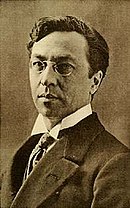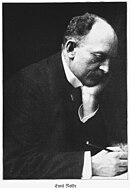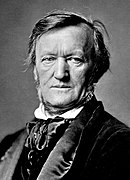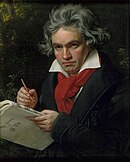Artists in The Aesthetics of Resistance
The artists in The Aesthetics of Resistance, of which there is a multitude that Peter Weiss included in his novel The Aesthetics of Resistance, form a kind of musée imaginaire (imagined museum) with more than a hundred named artists and just as many works of art, mainly visual arts and literature, but also performing arts and music.[1]
List of artists[edit]
The following list is a supplement to the list of artworks in The Aesthetics of Resistance and contains about one hundred names of artists who are discussed, named, enumerated or included in detail in the novel. They are largely arranged in the order of their appearance in the book.[2] Exceptions are motifs, which are given a more detailed description on later pages after a brief mention.
| Illustration / Chronology | Artist / Origin | Work / Classification | Entry in the novel |
|---|---|---|---|
 |
Max Ernst
1891–1976 |
Visual arts / Person
|
In the line-up of some modernist artists, especially Surrealism and Dadaism, whose paintings attacked social and political conditions and in which "flashes of fermentation and rot, panic and upheaval" could be seen. |
 |
Paul Klee
1879–1940 |
Visual arts / Person
|
in the line-up of some modernist artists, especially Surrealism and Dadaism, whose paintings attacked social and political conditions and in which
Paul Klee is revisited several times in the novel as an example of the relationship between art and politics:
Culture and politics grew together until 1933:
|
 |
Wassily Kandinsky
1866-1944 |
Visual arts / Person
|
enumerated by way of example:
enumerated in the series of some modernist painters, especially Surrealism and Dadaism, whose paintings attacked social and political conditions and in which there was a
Another mention in the novel is of Kandinsky as one of the painters about whose artistic revolution Leon Trotsky had commented on.[4][5] |
 |
Kurt Schwitters
1887–1948 |
Fine Arts / Person
|
listed by way of example:
in the line-up of some modernist painters, especially Surrealism and Dadaism, whose paintings attacked social and political conditions and in which
could be seen. |
 |
Salvador Dalí
1904-1989 |
Fine Arts / Person
|
listed by way of example:
in the line-up of some modernist painters, especially Surrealism and Dadaism, whose paintings attacked social and political conditions and in which
could be seen. |
 |
René Magritte
1898–1967 |
Fine Arts / Person
|
listed by way of example:
in the line-up of some modernist painters, especially Surrealism and Dadaism, whose paintings attacked social and political conditions and in which
could be seen. |
 |
Otto Dix
1891–1969 |
Fine Arts / Person
|
listed by way of example:
in the line-up of some painters of modernism, here especially of New Objectivity, whose pictures attacked the social and political conditions and
Culture and politics grew together until 1933:
|
 |
George Grosz
1893-1959 |
Fine Arts / Person
|
On the line-up of some painters of modernism, here especially of New Objectivity, whose pictures attacked the social and political conditions and
Towards the end of the novel, the idea is rounded off with his example, among others. Culture and politics grew together until 1933:
|
 |
Lyonel Feininger
1871–1956 Painter |
Fine Arts / Person
|
In the ranking of some modernist painters whose pictures attacked social and political conditions and whose pictures
The idea is taken up again in the discussion of Picasso's Guernica. |
 |
Emil Nolde
1867–1956 Painter |
Fine Arts / Person
|
In the line-up of some modernist painters whose pictures attacked social and political conditions and
Towards the end of the novel, the idea is rounded off with his example, among others. Culture and politics grew together until 1933:
|
 |
Oskar Kokoschka
1886-1980 Painter |
Fine Arts / Person
|
in the line-up of some modernist painters whose pictures attacked social and political conditions and "het up reality". |
 |
Max Beckmann
1884-1950 Painter |
Fine Arts / Person
|
In the line-up of some modernist painters whose pictures attacked social and political conditions and "het up reality". Towards the end of the novel, the idea is rounded off with his example, among others. Culture and politics grew together until 1933:
But the departure from this idealism is also questioned. Beckmann belonged to the left-wing verist wing of the New Objectivity, his works were ostracised by the Nazis as "degenerate", and he himself managed to emigrate in 1937. At a lecture in 1938, he adhered to a strict separation between spirit and politics and stated that he had never been politically active.[6] |
 |
Jean-François Millet
1814-1895 Painter |
Fine Arts / Person
|
With the discussion of some of Millet's paintings, his personal background is also included and it is asked whether a certain resistant potential can be read from his paintings due to his origins as a farmer's son. |
 |
Vladimir Mayakovsky
1893-1930 Writer |
Literature / Person
Mayakovsky was a leading exponent of Russian Futurism and was considered a Soviet model poet in the early 1920's. Towards the end of the 1920s, he criticised developments in Soviet society. On 14 April 1930, he shot himself in the heart with a pistol.
|
The protagonists take Mayakovsky in particular as an example of the upheaval in the Soviet Union's conception of culture and the suppression of expressionist statements by Stalinism:
|
 |
Kazimir Malevich
1879-1935 Painter |
Fine Arts / Person
|
In a ranking of artists whose expressionist statements were suppressed in the early Soviet Union and especially by Stalinism:
|
 |
James Joyce
1882-1941 Writer |
Literature / Person
|
In a ranking of artists whose art could change social being:
|
 |
Franz Kafka
1883-1924 Writer |
Literature / Person
|
Enumerated in a ranking of artists whose art could change social being:
Kafka's unfinished novel The Castle is one of the works discussed at length in the novel. |
 |
Arnold Schönberg
1874-1951 Composer |
Music / Person
|
Enumerated in a ranking of artists whose art could change social being:
|
 |
Igor Stravinsky
1882-1971 Composer |
Music / Person
|
Enumerated in a ranking of artists whose art could change social being:
|
 |
Pablo Picasso
1881-1973 Painter |
Fine Arts / Person
|
Enumerated in a ranking of artists whose art could change social being:
Picasso's painting Guernica is one of the works discussed at length in the novel. |
 |
Dante Alighieri
1265-1321 Poet and philosopher |
Literature / Person
|
Enumerated in a ranking of artists whose art could change social being: "We insisted that Joyce and Kafka, Schoenberg and Stravinsky, Klee and Picasso belonged to the same rank in which Dante found himself."
Dante's story The Divine Comedy is one of the works discussed at length in the novel. |
 |
Carola Neher
1900-1942 Actress |
Performing Arts / Person
|
In the context of the protagonists' discussion of Stalin's purges in the Soviet Union, Neher's arrest in July 1936, and indictment in the Moscow Trials. |
 |
Sergei Eisenstein
1898-1948 Director |
Performing Arts / Person
|
Example of a list of cultural contributions about Soviet film in the Arbeiter Illustrierte (AIZ): |
 |
Willi Bredel
1901-1964 Writer |
Performing Arts / Person
|
Example in a list of contemporary workers' writers:
|
 |
Friedrich Hölderlin
1770-1843 Poet |
Performing Arts / Person
|
Enumeration and juxtaposition of some personalities in the German cultural history:
|
 |
Johann Gottlieb Fichte
1762–1814 Philosopher |
Literature / Person
|
Enumeration and juxtaposition of some personalities in German cultural history:
|
 |
Ulrich von Hutten
1488–1523 Humanist |
Literature / Person
|
Enumeration and juxtaposition of some personalities in German cultural history: "(...) as also the enlightened, rational Hutten was displaced by the popular Luther". |
 |
Martin Luther
1483–1546 Theologian |
Literature / Person
|
Enumeration and juxtaposition of some personalities in German cultural history: "(...) as also the enlightened, rational Hutten was displaced by the popular Luther". |
 |
Johann Gottfried Herder
1744-1803 Poet |
Literature / Person
|
Enumeration and juxtaposition of some personalities in German cultural history:
|
 |
Johann Wolfgang von Goethe
1749–1832 Poet |
Literature / Person
|
Enumeration and juxtaposition of some personalities in German cultural history:
|
 |
Immanuel Kant
1724–1804 Philosopher |
Literature / Person
|
Enumeration and juxtaposition of some personalities in German cultural history:
|
 |
Georg Wilhelm Friedrich Hegel
1770–1831 Philosopher |
Literature / Person
|
Enumeration and juxtaposition of some personalities in German cultural history:
|
 |
Richard Wagner
1813-1883 Composer |
Music / Person
|
Enumeration and juxtaposition of some personalities in German cultural history:
|
 |
Ludwig van Beethoven
1770-1831 Composer |
Music / Person
|
Enumeration and comparison of some personalities in German cultural history:
|
 |
Thomas Mann
1875-1955 Writer |
Literature / Person
|
Mention of his career from liberal author to opponent of the fascist dictatorship and discussion of his relationship between art and politics. |
 |
Francisco de Goya
1746–1828 Painter |
Fine Arts / Person
|
Francisco de Goya, and his work in particular, is discussed several times in the course of the novel. First, he is mentioned in the first-person narrator's ideas of the country and republic of Spain through memories of
|
 |
Federico García Lorca
1898-1936 Writer |
Literature / Person
|
The first-person narrator's ideas of the country and republic of Spain are shaped by memories of
|
 |
Luis Buñuel
1900-1983 Director |
Performing Arts / Person
|
The first-person narrator's ideas of the country and republic of Spain are shaped by memories of
|
 |
Aeschylus
525 - 456 BC Poet |
Literature / Person
Aeschylus is the oldest of the three great Greek tragedians. He took part as a soldier for Athens in the battle of Marathon against the Persians in 490 BC.
|
He is mentioned as the role model of a protagonist in the Spanish Civil War:
|
 |
Eugène Delacroix
1798-1863 Painter |
Fine Arts / Person
|
Reflections on the personal background with which Delacroix painted the confrontation in Paris in 1830:
|
 |
Théodore Géricault
1791–1824 Painter |
Fine Arts / Person
|
An examination of the painter's personal background:
|
 |
Vincent van Gogh
1853–1890 Painter |
Fine Arts / Person
|
An examination of Van Gogh's work is made in several sections of the novel, particularly within the depiction of an imaginary scene in which the protagonists meet the artist in Montmartre:
|
 |
Émile Bernard
1868–1941 Painter |
Fine Arts / Person
Bernard was a friend of Van Gogh and is considered to have played a major role in Synthetic Symbolism.
|
Mention in an imaginary scene of meeting Van Gogh at the Café du Tambourin in Montmartre. |
 |
Henri Rousseau
1844–1910 Painter |
Fine Arts / Peraon
|
Description of the legendary banquet at the Bateau-Lavoir in 1908, celebrated on the occasion of the sale of a painting by Rousseau. The depiction in the novel is stylised like a self-portrait of the painter.[11][12] |
 |
Hans Arp
1886-1966 Painter and lyricist |
Visual Arts / Person
Hans Arp is considered one of the most important representatives of Dadaism and Surrealism in both visual art and literature. He was a member of the Abstraction-Création group.
|
List of artists who stood up for a revolting art:
|
 |
Ernst Toller
1893-1939 Writer |
Literature / Person
|
Portrayals of Toller's life and arguments about his political impact as well as his suicide after numerous personal setbacks and defeat in the Spanish Civil War. He killed himself because he saw no political way out.
|
 |
Carl von Ossietzky
1889-1938 Writer and journalist |
Literature / Person
|
Account by Rosalinde von Ossietzky-Palm, the daughter of Carl von Ossietzky, who is included as a protagonist in the novel, of the persecution and death of her father. |
 |
Bertolt Brecht
1898-1956 Writer |
Literature / Person
|
Depicted in a scene in the garden of the house in Lidingö where the "Brechtian extended family" lived in exile until the end of 1939. |
 |
Helene Weigel
1900-1971 Actor |
Performing Arts / Person
|
Depicted in a scene in the garden of the house in Lidingö where the "Brechtian extended family" lived in exile until the end of 1939. |
 |
Margarete Steffin
1908-1941 Writer, actor |
Literature / Person
|
Depicted in a scene in the garden of the house in Lidingö where the "Brechtian extended family" lived in exile until the end of 1939. |
 |
Ruth Berlau
1906-1974 Actress |
Performing Arts / Person
|
Depicted in a scene in the garden of the house in Lidingö where the "Brechtian extended family" lived in exile until the end of 1939. |
 |
Diego Velázquez
1599-1660 Painter |
Fine Arts / Person
|
Listed as court painter whose paintings were exhibited in the Royal Palace of El Pardo.[16] |
 |
Carl Fredrik Hill
1849–1911 Painter |
Fine Arts / Person
|
Listed as an example of a Swedish artist misunderstood by his time, driven to madness: |
 |
Ernst Josephson
1851–1906 Painter |
Fine Arts / Person
|
Listed as an example of a Swedish artist misunderstood by his time, driven to madness: |
 |
August Strindberg
1849-1912 Writer |
Literature / Person
|
Listed as an example of a Swedish artist who was misunderstood by his time, driven to madness:
|
 |
Alexander Girardi
1850-1918 Actor |
Performing Arts / Person Girardi enjoyed great success as a vocal comedian at the Theater an der Wien for well over 20 years at the end of the 19th century and around the turn of the century. One of his famous roles was Torelli in the play Künstlerblut by Edmund Eysler.
|
Listed during the extensive enumeration of Brecht's library as a statement by Brecht, who could not part with a book about Girardi's life:
|
 |
Karin Boye
1900-1941 Writer |
Literature
Boye's poetry reflects all the intellectual currents of modernity. Her main work, the novel Kallocain, is strongly influenced by Jonathan Swift and takes a very gloomy view of the future. On 24 April 1941, Karin Boye committed suicide by poisoning in a forest near Alingsås.
|
The writer is the protagonist in the third part of the novel and influences the development of the first-person narrator as a writer in a field of tension contrasted with Brecht. Her last months in Alingsås and her suicide are also depicted. |
| Elisabeth Schumacher
1904-1942 Graphic artist |
Fine Arts / Person Elisabeth Schumacher was a resistance fighter in the circle of the Red Orchestra (Rote Kapelle). She was executed on 22 December 1942 in Plötzensee prison.
|
Elisabeth Schumacher is named several times in the novel for her history in the resistance, but her artistic work is not listed.[19] | |
| Oda Schottmüller
1905-1943 Dancer and sculptor |
Performing Arts / Person Oda Schottmüller was an active member of the Red Orchestra (Rote Kapelle) and was executed on 5 August 1943 together with Liane Berkowitz, Cato Bontjes van Beek, Eva-Maria Buch, Hilde Coppi, Ursula Goetze, Emil Hübner, Adam Kuckhoff, Ingeborg Kummerow, Klara Schabbel, Rose Schlösinger, Maria Terwiel, Frida Wesolek and Stanislaus Wesolek in Plötzensee prison.
|
Schottmüller is mentioned several times in the novel. The scene of the execution of the members of the Red Orchestra on 5 August 1943 and other murders of resistance fighters against Nazism, choreographically described as a dance of death, is haunting.[20][19] | |
| Kurt Schumacher
1905-1942 Sculptor |
Fine Arts / Person
|
Mentioned several times, especially his farewell letter, in which he consoled himself,
| |
 |
Tilman Riemenschneider
1460-1531 Sculptor |
Fine Arts / Person
Riemenschneider is considered one of the most important carvers and sculptors in the transition from the late Gothic to the Renaissance.
|
The sculptor mentioned by Kurt Schumacher in his farewell letter was arrested and tortured after his involvement in the Peasants' Wars |
| Jerg Ratgeb
1480-1526 Sculptor |
Fine Arts / Person Ratgeb lost his rights as a citizen of Heilbronn because of his marriage to a serf and moved to Stuttgart. As a member of the council, he negotiated with the rebellious peasants in 1525, by whom he was elected as war councillor and chancellor. After the suppression of the rebels, he was accused of high treason and executed in Pforzheim in 1526.
|
Kurt Schumacher includes the sculptor in his farewell letter. | |
 |
Veit Stoss
1447-1533 Sculptor |
Fine Arts / Person
|
The sculptor mentioned by Kurt Schumacher in his farewell letter was branded on both cheeks with red-hot iron after being charged with forgery of documents. |
| Hilde Rubinstein
1904-1997 Painter and poet |
Fine Arts / Person Hilde Rubinstein was imprisoned as a member of the Communist Party of Germany in 1933, was able to emigrate via Belgium and the Netherlands in 1934 and reached Sweden in 1935. In 1936 and 1937 she lived in the Soviet Union, but was threatened with extradition to the German Reich for Trotskyist activities. She fled to Sweden again via Poland and Latvia. She secured her livelihood with various temporary jobs, and later worked as a painter and writer. After the war she stayed in Gothenburg.
|
Mentioned among many other listed artists who had made odysseys and sought opportunities for their artistic work in Swedish exile. |
See also[edit]
References[edit]
- ^ Badenberg, Nana (1995). "Die Ästhetik und ihre Kunstwerke. Eine Inventur". In Honold, Alexander; Schreiber, Ulrich; Badenberg, Nana (eds.). Die Bilderwelt des Peter Weiss (in German) (1st ed.). Hamburg: Argument-Verlag. p. 115. ISBN 9783886192274.
- ^ Weiss, Peter (1988). Die Ästhetik des Widerstand (in German). Frankfurt: Suhrkamp. ISBN 3518115014.
The page references to the Suhrkamp edition (es 1501) Volumes I to II, paginated volume by volume. The article source reference is abbreviated in footnotes as AedW and according to volume number I to III
- ^ Weiss Volume I, p. 79.
- ^ Weiss Volume II, p. 57.
- ^ a b Badenberg & Kommentiertes Verzeichnis 1995, p. 194.
- ^ Badenberg & Kommentiertes Verzeichnis 1995, p. 167.
- ^ Weiss Volume I, p. 184.
- ^ a b Weiss Volume I, p. 347.
- ^ Badenberg & Kommentiertes Verzeichnis 1995, p. 176.
- ^ Badenberg & Kommentiertes Verzeichnis 1995, p. 183.
- ^ a b Weiss Volume II, p. 35.
- ^ Badenberg & Kommentiertes Verzeichnis 1995, p. 220.
- ^ Weiss Volume II, p. 55.
- ^ Badenberg & Kommentiertes Verzeichnis 1995, p. 166.
- ^ Weiss Volume II, p. 173.
- ^ Badenberg & Kommentiertes Verzeichnis 1995, p. 229.
- ^ a b Weiss Volume I, p. 281.
- ^ Badenberg & Kommentiertes Verzeichnis 1995, p. 192.
- ^ a b Badenberg & Kommentiertes Verzeichnis 1995, p. 223.
- ^ Weiss Volume I, p. 233.
- ^ Weiss Volume III, p. 214.
Bibliography[edit]
- Badenberg, Nana (1995). "Kommentiertes Verzeichnis der in der Ästhetik des Wider-stands erwähnten bildenden Künstler und Kunstwerke". In Honold, Alexander; Schreiber, Ulrich (eds.). Die Bilderwelt des Peter Weiss (in German) (1st ed.). Hamburg: Argument-Verlag. pp. 163–231. ISBN 9783886192274.
- Weiss, Peter (1988). Aesthetik des Widerstands. Edition Suhrkamp, 1501 (in German). Vol. I. Frankfurt: Suhrkamp. ISBN 9783518115015. OCLC 1283249147.
- Weiss, Peter (1988). Aesthetik des Widerstands. Edition Suhrkamp, 1501 (in German). Vol. II. Frankfurt: Suhrkamp. ISBN 9783518115015. OCLC 1283249147.
- Weiss, Peter (1988). Aesthetik des Widerstands. Edition Suhrkamp, 1501 (in German). Vol. III. Frankfurt: Suhrkamp. ISBN 9783518115015. OCLC 1283249147.
